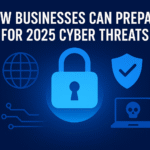Introduction
Cybersecurity is no longer just a concern for IT departments; it impacts everyone. From individuals using smartphones to global corporations managing sensitive data, online safety is essential. As we enter 2025, the landscape of digital threats and defenses continues to evolve. This article explores the top cybersecurity trends for 2025, giving you insight into how the world is preparing to stay safe in the digital age.
1. AI-Powered Cyber Defense
Artificial intelligence (AI) is becoming a double-edged sword in cybersecurity. On one side, attackers are using AI to create more advanced phishing scams, malware, and deepfakes. On the other hand, cybersecurity professionals are harnessing AI to predict, detect, and respond to attacks in real time.
Expect 2025 to bring widespread adoption of AI tools that automatically analyze network behavior, spot anomalies, and recommend fixes before major damage occurs.
2. Rise of Quantum Security Preparations
Quantum computing is not yet mainstream, but it poses a massive future threat to encryption. Hackers may already be “harvesting” encrypted data today, planning to decrypt it once quantum computing matures.
In 2025, many organizations will start adopting post-quantum cryptography — encryption methods resistant to quantum attacks. Governments and tech companies alike are investing heavily in this shift.
3. Identity and Access Management (IAM) Takes Center Stage
Weak or stolen credentials remain one of the biggest security risks. In 2025, identity security will be at the forefront. This means stronger multi-factor authentication (MFA), passwordless logins using biometrics, and AI-driven monitoring of user behavior.
Businesses will prioritize zero trust frameworks — “never trust, always verify” — to secure access at every level.
4. Expansion of Cyber Insurance
As attacks grow in frequency and cost, cyber insurance is becoming a standard part of business strategy. In 2025, policies will expand but also become stricter. Insurance providers will require companies to prove they have strong defenses (such as MFA, encryption, and regular backups) before offering coverage.
This trend will push organizations to improve their security not just for safety, but for compliance and financial protection.
5. Growth of Ransomware-as-a-Service (RaaS)
Ransomware remains one of the biggest threats. In 2025, cybercriminal groups will continue to offer Ransomware-as-a-Service kits on the dark web, making it easier for even non-technical attackers to launch attacks.
We’ll also see ransomware evolve beyond just encrypting files — attackers will increasingly threaten to leak sensitive data unless paid.
6. Cloud Security Becomes Non-Negotiable
With more businesses relying on cloud services, securing cloud data is crucial. In 2025, misconfigured cloud systems will remain a top attack vector. Companies will invest in cloud security posture management (CSPM) tools to ensure compliance and protection.
Hybrid and multi-cloud environments will require more unified security strategies to avoid gaps that attackers can exploit.
7. Supply Chain Security Under Pressure
Cyberattacks on suppliers and third-party vendors can have devastating ripple effects. The 2020 SolarWinds breach proved how dangerous supply chain compromises can be. In 2025, organizations will invest in vendor risk management, requiring partners to meet stricter security standards.
Expect tighter collaboration between industries to share intelligence and strengthen collective defense.
8. Focus on Human-Centered Security
Technology alone cannot stop cyberattacks; humans remain the weakest link. In 2025, companies will emphasize employee cybersecurity training. Programs will simulate phishing attempts, test responses, and ensure that workers can spot scams.
By blending awareness with technology, organizations hope to reduce human errors that lead to breaches.
9. Cybersecurity Regulations and Compliance
Governments worldwide are stepping up digital safety rules. In 2025, stricter data protection regulations will shape how businesses collect, store, and use personal information. Industries like healthcare, finance, and critical infrastructure will face tougher compliance demands.
Failing to follow these rules could mean heavy fines, making compliance a top priority.
10. IoT and 5G Security Challenges
The rise of Internet of Things (IoT) devices and 5G networks brings convenience but also new risks. Billions of connected devices — from smart homes to industrial sensors — can be targeted if not secured properly.
In 2025, we’ll see more investment in IoT security standards, firmware updates, and monitoring tools to prevent large-scale attacks.
Conclusion
The world of cybersecurity in 2025 is shaped by both new opportunities and growing risks. AI will play a key role on both sides of the battlefield, while post-quantum security, ransomware threats, and human error continue to challenge defenses.
Staying informed and proactive is the best way to stay safe. By understanding these trends, businesses and individuals can prepare for the future and build stronger digital resilience.



